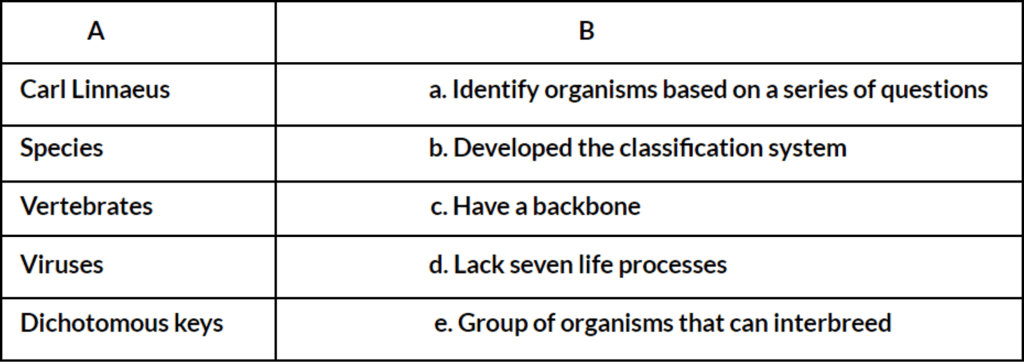Worksheet: Classification | IGCSE Cambridge Science for Year 7 - Class 7 PDF Download
| Table of contents |

|
| Multiple Choice Questions (MCQs): |

|
| Fill in the Blanks: |

|
| True or False: |

|
| Match The Following |

|
Multiple Choice Questions (MCQs):
Q1. What is used primarily to classify organisms into different groups?
A) Behavior
B) Characteristics
C) Habitat
D) Size
Answer: B) Characteristics
Explanation: Organisms are classified based on their similarities and differences in characteristics, such as physical traits and genetic features.
Q2. Which characteristic is not shared between humans and tigers?
A) Hair
B) Two legs
C) Fur
D) Warm-blooded
Answer: B) Two legs
Explanation: Unlike humans, tigers have four legs, which highlights a significant difference in their physical characteristics.
Q3. What type of plants would you classify under the group that includes mosses?
A) Flowering plants
B) Conifers
C) Non-flowering plants
D) Ferns
Answer: C) Non-flowering plants
Explanation: Mosses are classified under non-flowering plants, which do not produce flowers or seeds.
Q4. Who introduced the system to classify organisms based on characteristics in the 18th century?
A) Charles Darwin
B) Gregor Mendel
C) Carl Linnaeus
D) Louis Pasteur
Answer: C) Carl Linnaeus
Explanation: Carl Linnaeus was pivotal in developing a classification system based on organism characteristics, which is still in use.
Q5. What is the smallest group in the Linnaean system identified by two Latin names?
A) Order
B) Genus
C) Family
D) Species
Answer: D) Species
Explanation: In Linnaean taxonomy, a species is the smallest unit, identified by a binomial nomenclature consisting of two Latin names.
Fill in the Blanks:
Q1. Variation refers to the differences in __________ among organisms within the same group.
Answer: characteristics
Explanation: Variation means the differences observed in the characteristics of organisms that are grouped together.
Q2. The classification system that involves kingdoms requires __________ examination to observe cellular structures.
Answer: microscopic
Explanation: Many characteristics used for classifying organisms into kingdoms, like cellular structures, need to be observed under a microscope.
Q3. Hybrids are usually __________, meaning they cannot produce offspring.
Answer: infertile
Explanation: Hybrids, the offspring of two different species, are typically infertile and cannot reproduce.
Q4. __________ keys are used to identify and classify organisms using a series of questions.
Answer: Dichotomous
Explanation: Dichotomous keys help in the identification and classification of organisms through a sequential approach using questions with two possible answers.
Q5. Flowering plants are distinguished by their __________ systems and __________ shapes.
Answers: root, leaf
Explanation: Flowering plants have distinctive root systems and leaf shapes, which are important for classification.
True or False:
Q1. All animals in the Animal Kingdom are vertebrates.
Answer: False
Explanation: The Animal Kingdom includes both vertebrates (animals with backbones) and invertebrates (animals without backbones).
Q2. The Linnaean system is no longer used in modern taxonomy.
Answer: False
Explanation: Despite advancements in genetic data, the Linnaean system of classification continues to be a foundational framework in taxonomy.
Q3. All trees produce flowers.
Answer: False
Explanation: Not all trees produce flowers; for example, conifers produce cones instead of flowers.
Q4. Viruses are considered living organisms.
Answer : False
Explanation: Viruses are not considered living organisms as they lack the seven life processes.
Q5. Leaf characteristics, such as edges, shape, and arrangement, can be useful in identifying specific trees or plants.
Answer: True
Explanation: Leaf characteristics (edges, shape, arrangement) are often useful for identifying specific trees or plants.
Match The Following

Answer:
Carl Linnaeus - b. Developed the classification system
Species - e. Group of organisms that can interbreed
Vertebrates - c. Have a backbone
Viruses - d. Lack seven life processes
Dichotomous keys - a. Identify organisms based on a series of questions
|
32 videos|61 docs|22 tests
|
FAQs on Worksheet: Classification - IGCSE Cambridge Science for Year 7 - Class 7
| 1. What is the purpose of classifying organisms? |  |
| 2. How are organisms classified into different groups? |  |
| 3. What are the main classification categories used in biology? |  |
| 4. Why is it important to understand the classification of organisms? |  |
| 5. How does the Linnaean classification system work? |  |















